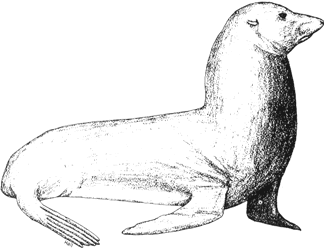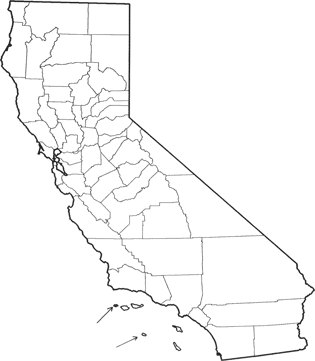
Guadalupe Fur Seal
Distribution, Abundance, and Seasonality
Guadalupe fur seals are rarely observed in California. Their entire breeding population is centered on Isla de Guadalupe, 256 km (159 mi) west of Baja California, Mexico. Occasionally they occur on San Miguel Island, San Nicolas Island, and once, on San Clemente Island in southern California. One adult male maintained a territory among breeding California sea lions on San Miguel Island (DeLong 1975, Le Boeuf et al. 1976). In 1938, 3 young males were sighted at Piedras Blancas in San Luis Obispo Co. (Bonnot et al. 1938). Before exploitation, Guadalupe fur seals bred on other Mexican islands, Channel Islands, and possibly on Farallon Islands (Hubbs 1956, Bartholomew 1967, Fleischer 1978a, Walker and Craig 1979). Commercially hunted nearly to extinction in the 1800's, only 7 individuals were observed on Isla de Guadalupe in 1892 (Townsend 1899). Subsequent recovery has been slow; the current population is estimated at 2000 (Pierson 1978, Le Boeuf and Bonnell 1980). Inhabits rocky insular shorelines; often found in sheltered crevices and sea caves. Rarely observed at sea.

Range Map
Specific Habitat Requirements
Feeding: Little information. Appear to feed opportunistically on a variety of fish and invertebrates, particularly on rockfish at Isla de Guadalupe (Fleischer 1978b, Bonner 1981).
Cover: Found in shallow, nearshore island waters. Prefer cool and sheltered rocky habitats along steep shelving shorelines. Haul out on rock platforms with access to water and in sea caves. Lava blocks and boulders, deep crevices, and tidepools are present at many haul-out sites (Peterson et al. 1968).
Reproduction: Breeding activities take place on land, as well as in tidepools and in shallow surf-zone waters. Females alternate periods of feeding at sea and nursing their pup on land (Pierson 1978).
Water: Freshwater probably obtained from prey consumed and through metabolic processes.
Pattern: Prefer isolated, rocky haul-out and breeding sites with easy access. Sea caves, crevices, and large boulders enhance suitability of habitat by providing protection from solar radiation, wind, and surf.
Species Life History
Activity Patterns: Active yearlong; probably circadian activity pattern.
Seasonal Movements / Migration: Little is known of seasonal movements other than that they do occur to some extent. After the breeding season, in August, adult males evidently leave the breeding area, returning in May; some travel northward up to 600 km (370 mi). Females and juveniles are present on the island throughout most of the year, with the exception of May, when relatively few are observed (Pierson 1978).
Home Range: No information found.
Territory: During the breeding season, males establish and defend territories with well-defined boundaries which extend for several meters into the water. Preferred territories provide shelter from sun, wind, and rough seas, as well as easy access to water. Displacement of territorial males rarely occurs. Bulls may return to the same territory in the following breeding season; one bull held the same territory for as long as nine successive breeding seasons (Pierson 1978).
Reproduction: Breed May to July; peak pupping occurs in late-June. Polygynous; males fast while maintaining territories for an average of 6 wk. Bulls often herd females in an attempt to prevent them from leaving, or to force a landing on their territory. Females give birth to a single pup soon after arrival, mate about 1 wk after parturition, and leave their pup, to feed at sea soon after copulating. Each feeding trip lasts from 2-6 days. Females nurse and remain with their pup for at least 8 mo (Pierson 1978).
Niche: May be attacked by great white sharks (Carcharodon carcharias) (Le Boeuf et al. 1982).
Comments: Formerly referred to by some authors as southern fur seal (A. philippi).
Sources & References
California Department of Fish and Game, 1999.
California's Wildlife, Sacramento, CA.
Written by: M. L. Riedman, reviewed by: H. Shellhammer, edited by: J. Harris, R. Duke
Bartholomew, G. A. 1967. Seal and sea lion populations of the California Islands. Pages 227-244 in R. N. Philbrick, ed. Proceedings of the symposium on the biology of the California Islands. Santa Barbara Botanic Garden, Santa Barbara, Calif. 363pp. Bonner, W. N. 1981. Southern fur seals-Arctocephalus. Pages 161-208 in S. H. Ridgeway and R. J. Harrison, eds. Handbook of marine mammals, vol.1. Academic Press, London. 235pp. Bonnot, P., G. H. Clarke, and S. R. Hatton. 1938. California sea lion census for 1938. Calif. Fish and Game 24:415-419. DeLong, R. L. 1975. San Miguel Island management plan. U.S. Marine Mammal Commission, Washington, DC. 38pp. Fleischer, L. A. 1978a. The distribution, abundance and population characteristics of the Guadalupe fur seal, Arctocephalus townsendi (Merriam, 1897). M.S. Thesis, Univ. Washington, Seattle. 93pp. Fleischer, L. A. 1978b. Guadalupe fur seal. Pages 160-165 in D. Haley, ed. Marine mammals of Eastern North Pacific and Arctic waters. Pacific Search Press, Seattle, Wash. 256pp. Hubbs, C. L. 1956. Back from oblivion? Guadalupe fur seal:still a living species. Pac. Discovery 9:14-21. Le Boeuf, B. J., and M. L. Bonnell. 1980. Pinnipeds of the California islands: abundance and distribution. Pages 475-493 in D. Power, ed. The California islands. Santa Barbara Mus. Nat. Hist. 787pp. Le Boeuf, B. J., M. L. Bonnell, M. O. Pierson, D. H. Dettman, and G. D. Farrens. 1976. Numbers, distribution and movements of pinnipeds in the Southern California Bight. USDI, Bur. Land Manage., Wash., DC. Final Rep. 1975-1976. 269pp. Le Boeuf, B. J., M. L. Riedman, and R. S. Keyes. 1982. White shark predation on pinnipeds in California coastal waters. Fish. Bull. 80:891-895. Peterson, R. S., C. L. Hubbs, R. L. Gentry, and R. L. DeLong. 1968. The Guadalupe fur seal: habitat, behavior, population size and field identification. J. Mamal. 49:665-675. Pierson, M. O. 1978. A study of the population dynamics and breeding behavior of the Guadalupe fur seal, Arctocephalus townsendi. Ph.D. Thesis, Univ. California, Santa Cruz. 110pp. Townsend, C. H. 1899. Pelagic sealing. With notes on the fur seals of Guadalupe, the Galapagos and Lobos Islands. Pages 233-274 in D. S. Jordan, ed. The fur seal and fur seal islands of the North Pacific Ocean. Part 3. U.S. Gov. Printing Off., Washington, DC. Walker, P. L., and S. Craig. 1979. Archaeological evidence concerning the prehistoric occurrence of sea mammals at Point Bennett, San Miguel Island. Calif. Fish and Game 65:50-54.
California Animal Facts | California's Wildlife